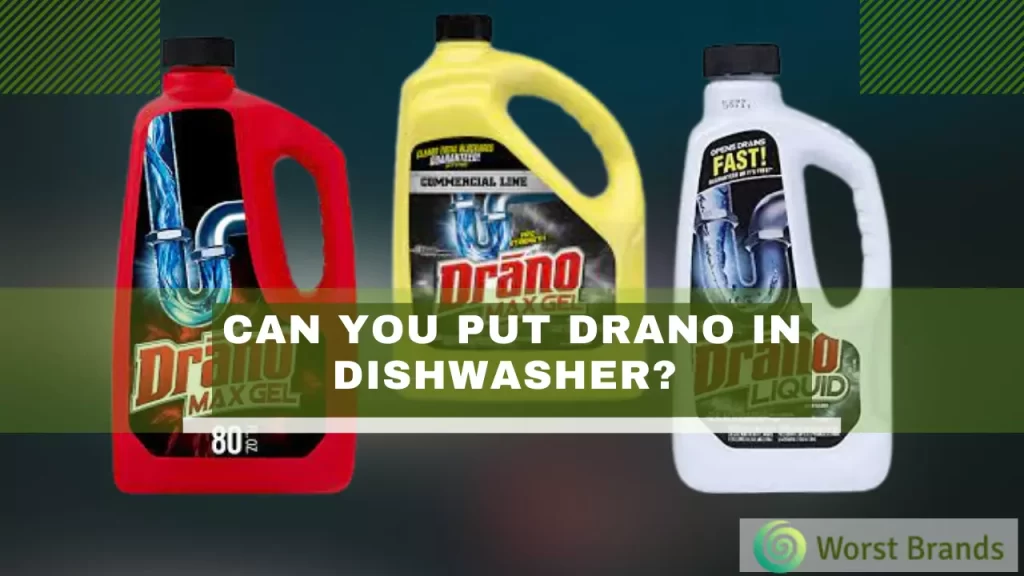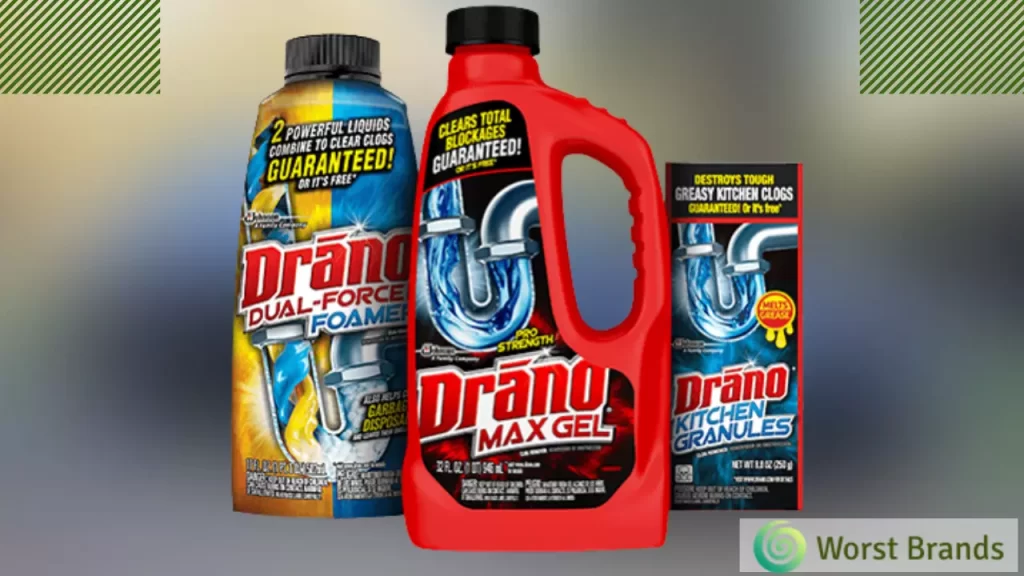Your kitchen is the place that is at a high stake of growing bacteria, fungus, and other harmful germs. Casual handling of food leftovers and improper drainage of wastewater can be the reason for bacterial growth and foul odor.
While cleaning, you might question yourself: Can you put Drano in a dishwasher? Let us tell you!
No, you cannot Put Drano in your dishwasher. The chemicals in Drano can damage the seals and gaskets of your dishwasher. Moreover, if it comes into contact with your hands, it can cause skin burns and rashes. Hence, you should always wash dishes with dish soap instead of Drano.

Related: Worst Dishwasher Brands to Avoid
Drano is basically a drain cleaner, and it is used to remove the coagulation of soap, hair, grease, and any other blockage within the drainage pipes.
You can use Drano in your sink if you want to use it to remove the buildup of soap and food residue in your drain.
However, Drano is not recommended in dishwashers, and it is not dishwasher safe.
Table of Contents
- Can You Use Drano in Dishwasher?
- Why Not Use Drano in a Dishwasher?
- How to Unclog a Dishwasher without Using Drano?
- Step 1: Empty the dishwasher
- Step 2. Turn off your dishwasher
- Step 3: Remove all the stagnant water
- Step 4: Check and clean the filter
- Step 5: Check and clean the drain hose
- Step 6: Place filter and drain hose
- How to Use Drano for Everyday Cleaning:
- FAQs
- Q: Is Drano Going To Ruin Your Dishwasher?
- Q: Is Drano Effective in Unclogging Dishwashers?
- Conclusion:
- Steven Settles
Can You Use Drano in Dishwasher?
You should not use a Drano in a dishwasher since it might corrode the drain pump and damage the dishwasher’s rubber seals.
You cannot use Drano on all types of plastic. It can melt plastic, and as a result, poisonous residuals will be left, resulting in a serious health hazard.
Drano contains several toxic materials, and they can reside in your dishwasher for a longer period.
Why Not Use Drano in a Dishwasher?
Most Drano products use Bleach, Sodium hydroxide, and Aluminum as their common ingredient.
When these materials are used to open the coagulated drain, they cause a heat-generating reaction.
This heat has enough temperature to melt PVC plumbing pipes, dishwasher drain pumps, and plastic parts. It will damage your dishwasher severely.
The result will be a high cost to repair the dishwasher again and again.

How to Unclog a Dishwasher without Using Drano?
Now a big question is how we can unclog a dishwasher. It is not difficult or technical to clean your dishwasher at home.
You need a few bits and pieces to do it.
Step 1: Empty the dishwasher
Remove all dishes and utensils from the dishwasher. You also need to remove the bottom dishwasher rack to easily access the machine.
Step 2. Turn off your dishwasher
Once the dishwasher, disconnect the power supply of your dishwasher and garbage disposal.
Step 3: Remove all the stagnant water
Removal of stagnant water properly reduces the risk of slipping and falling. You need to soak the stagnant water with a towel or wet vac.
You can also use a small hand siphon pump to remove stagnant water.
Step 4: Check and clean the filter
You need to check the filter for any blockage or accumulation of debris in it.
To remove some filters, you will need a screwdriver; otherwise, you will need a handle or a small lever.
Use a toothbrush or a fork to remove the particles trapped in the filter.
Place the filter in its place after cleaning it.
Step 5: Check and clean the drain hose
The drain hose is a tube that links your garbage disposal to your dishwasher. It can be found beneath your sink or behind the dishwasher.
If it is behind the dishwasher, you need to move the dishwasher away to access the drain hose.
Once you have located the drain hose, separate it from the dishwasher with tongue-and-groove pliers.
Use a flashlight to look for any clog; use commercial de-cloggers to remove them if it is there.
Step 6: Place filter and drain hose
After checking everything and removing the entire clog, it’s time to reinstall the filter and hose at their place. Place racks on their positions. You can now use your dishwasher again.
How to Use Drano for Everyday Cleaning:
Drano Liquid is an ideal solution and safe to be used in garbage disposals, kitchen, bathroom, and other drains blockage due to soap, hair, or grease.
- Carefully open the childproof cap by pushing it down with your palm and turning the cap anticlockwise. Don’tDon’t pour the liquid at once; always pour it slowly and gently.
- If your drain is half clogged and water goes slowly, pour half of the bottle. If your drain is completely clogged, pour the entire Drano Liquid into it.
- Let the Drano reach the area where coagulation occurred. Now, wait for 15 to 30 minutes.
- When the waiting time is over, flush the drain with hot water. It will eradicate the remaining clogged material.
Always use Drano with caution. When using Drano Liquid, keep your hands, face, and children away from the coagulated drain.
FAQs
Q: Is Drano Going To Ruin Your Dishwasher?
Yes. Drano is extremely corrosive and will eventually destroy your dishwasher. It can also cause other damage to your appliance if left in your dishwasher for too long.
Q: Is Drano Effective in Unclogging Dishwashers?
Drano is effective in unclogging dishwashers, but it should be used only in a very limited amount or never used at all. It can damage the inner parts of your dishwasher if used frequently, and it can cause clogs in your pipes too.
You may like to know:
- Can You Put Stainless Steel in Dishwasher?
- Are HydroFlasks Dishwasher Safe?
- Can You Put Yeti In Dishwasher?
- Can You Put Pans In The Dishwasher?
- Can You Wash Clothes in a Dishwasher?
Conclusion:
Drano is very good at clearing the coagulated pipes but never uses it to clean the dishwasher. But, it is not recommended to use in a dishwasher because of the acidic nature of the liquid.
You can use Drano Liquid to unclog the pipes but never use it to clean the dishwasher.
However, using Drano can be extremely hazardous; it is best to have your dishwasher or any other sink pipe unclogged by a professional.

Steven Settles is an ISCET-certified master in appliance repair. He has aced the National Appliance Service Technician Certification Exam, showcasing his exceptional diagnostic and repair skills. With an in-depth understanding of the latest repair technologies and a keen eye on evolving industry standards, Steven is a go-to expert for any appliance issue.